Articles Index
Reference Objects and Garbage
Collection
By Monica Pawlan  The Reference Object
application programming interface (API) is new in the Java™ Development Kit
(JDK™) 1.2. This API allows a program to maintain special references to objects that
allow the program to interact with the garbage collector in limited ways. Not all programs
require this level of interaction with the garbage collector. For example, a program that
keeps a lot of objects in memory or a program that needs to perform cleanup operations on
related objects before an object is reclaimed might be good candidates for using the
Reference Objects API.
The Reference Object
application programming interface (API) is new in the Java™ Development Kit
(JDK™) 1.2. This API allows a program to maintain special references to objects that
allow the program to interact with the garbage collector in limited ways. Not all programs
require this level of interaction with the garbage collector. For example, a program that
keeps a lot of objects in memory or a program that needs to perform cleanup operations on
related objects before an object is reclaimed might be good candidates for using the
Reference Objects API.
- A web-based program might display a lot of images
when an end user goes to a particular page on the web. If the end user leaves the page, it
is not always certain he or she will return. Such a program can use reference objects to
create a situation where the garbage collector reclaims the images when heap memory runs
low. In the event the end user returns to the page, the program can reload the image if it
has been reclaimed.
- A program can use a reference queue to create a
situation where the program is notified when a certain object is reachable only through
reference objects. Upon notification, the program can proceed with clean-up operations on
other related objects to make them eligible for garbage collection at the same time.
Because it is essential to understand garbage
collection before you can understand how reference objects work, this article begins by
describing how garbage collection works when no reference objects are involved, followed
by a discussion of how things change when reference objects are added to the heap.
Vanilla Garbage Collection
The garbage collector's job is to identify
objects that are no longer in use and reclaim the memory. What does it mean for an object
to be in use?
Note: An object is in use if it can be
accessed or reached by the program in its current state.
An executing Java™ program consists of a
set of threads, each of which is actively executing a set of methods (one having called
the next). Each of these methods can have arguments or local variables that are references
to objects. These references are said to belong to a root set of references that
are immediately accessible to the program. Other references in the root set include static
reference variables defined in loaded classes, and references registered through the Java Native Interface
(JNI) API.
All objects referenced by this root set of
references are said to be reachable by the program in its current state and must
not be collected. Also, those objects might contain references to still other objects,
which are also reachable, and so on.
All other objects on the heap are considered unreachable,
and all unreachable objects are eligible for garbage collection. If an unreachable object
has a finalize() method, arrangements are made for the object's finalizer to be called.
Unreachable objects with no finalizers and objects whose finalizers have been called are
simply reclaimed during garbage collection.
Garbage collection algorithms vary, but they all
have in common the task of identifying the objects that are reachable from the root set
and reclaiming the space occupied by any other objects.
In the diagram, which is a simplified view of
the stack and heap for instructional purposes, objects inside the blue square are
reachable from the thread root set, while objects outside the square (in red) are
not.
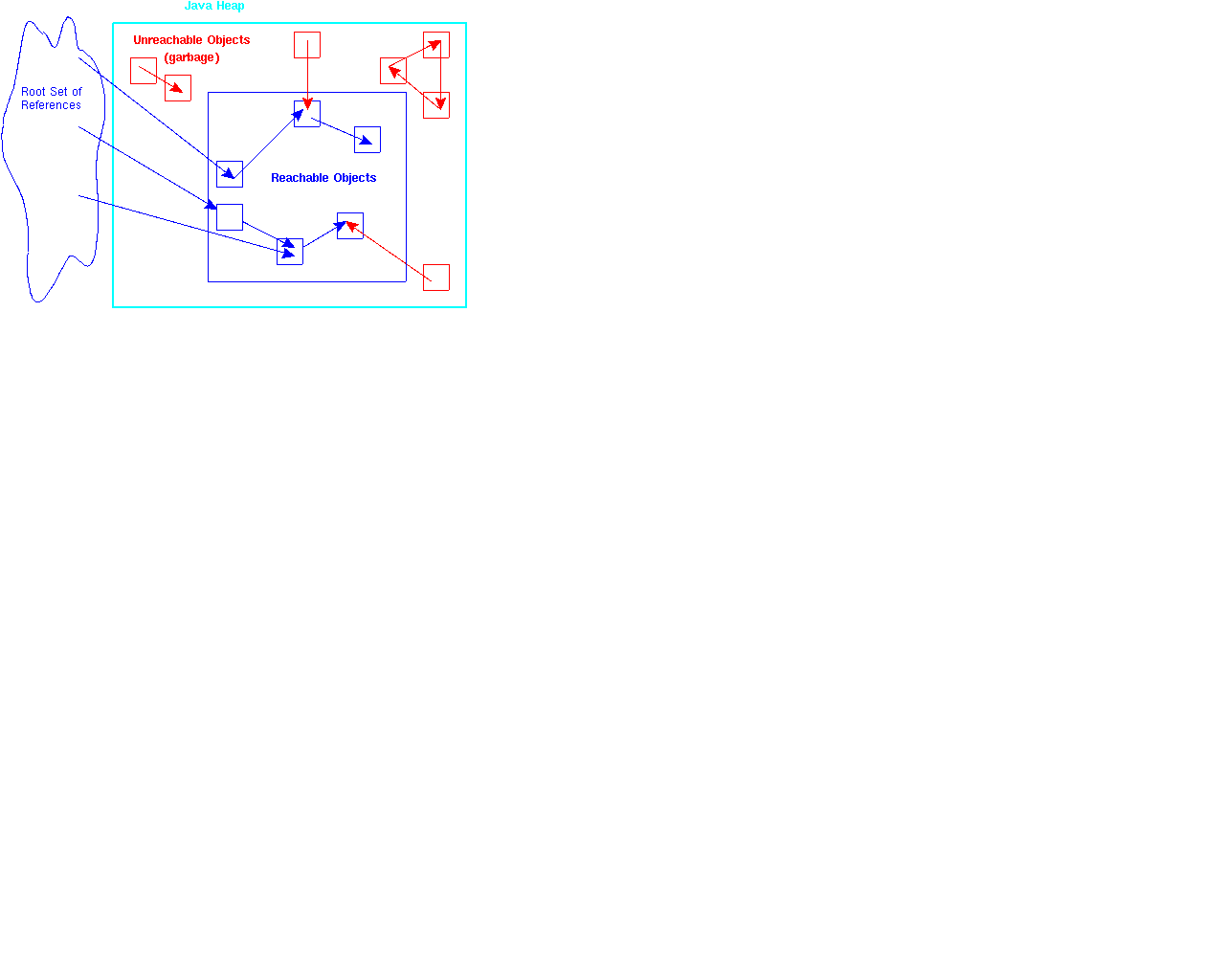
Fig.1: How garbage collection works.An
object may refer to reachable objects and still be unreachable itself. Likewise, an object
can be unreachable in spite of references to it, if those references are all from
unreachable objects.
Conservative Garbage Collection: If you
use the Java Native
Interface (JNI) API to make C calls, the garbage collector might see something in
memory created by the C code that looks like a pointer, but is actually garbage. In this
case, the memory is not garbage collected because the Java VM is conservative and does not
reclaim memory that looks like it could be allocated to a pointer.
What Happens When You Use Reference Objects
How does the introduction of reference objects
change things? Unlike ordinary references, the reference in a reference object is treated
specially by the garbage collector. A reference object encapsulates a reference to some
other object, which is called the referent.
The referent of a reference object is specified
when the reference object is created. In the following code, image is an image
object passed to sr, a SoftReference object. The image object is the
referent of sr, and the reference field in sr is a soft reference to image.
Image image = (sr == null) ? null : (Image)(sr.get());
if (image == null) {
image = getImage(getCodeBase(), "truck1.gif");
sr = new SoftReference(image);
}
Object Reachability
Besides strongly reachable and unreachable
objects, the Reference Objects API gives you strengths of object reachability. You can
have softly, weakly and phantomly reachable objects and gain a limited amount of
interaction with the garbage collector according to the strength of the object's
reachability.
The next sections explain these strengths and
how to use them. This section takes a look at how garbage collection is changed when two
of the objects on the heap in Figure 1 are changed to weak reference objects.
When an object is reachable from the root set by
some chain of ordinary references (no reference objects involved), that object is said to
be strongly reachable. If, however, the only ways to reach an object involve at
least one weak reference object, the object is said to be weakly reachable. An
object is considered by the garbage collector to be in use if it is strongly reachable.
Weakly reachable objects, like unreachable objects, are eligible for collection.
So, weak references allow you to refer to an
object without keeping it from being collected. If the garbage collector collects a weakly
reachable object, all weak references to it are set to null so the object can no
longer be accessed through the weak reference.
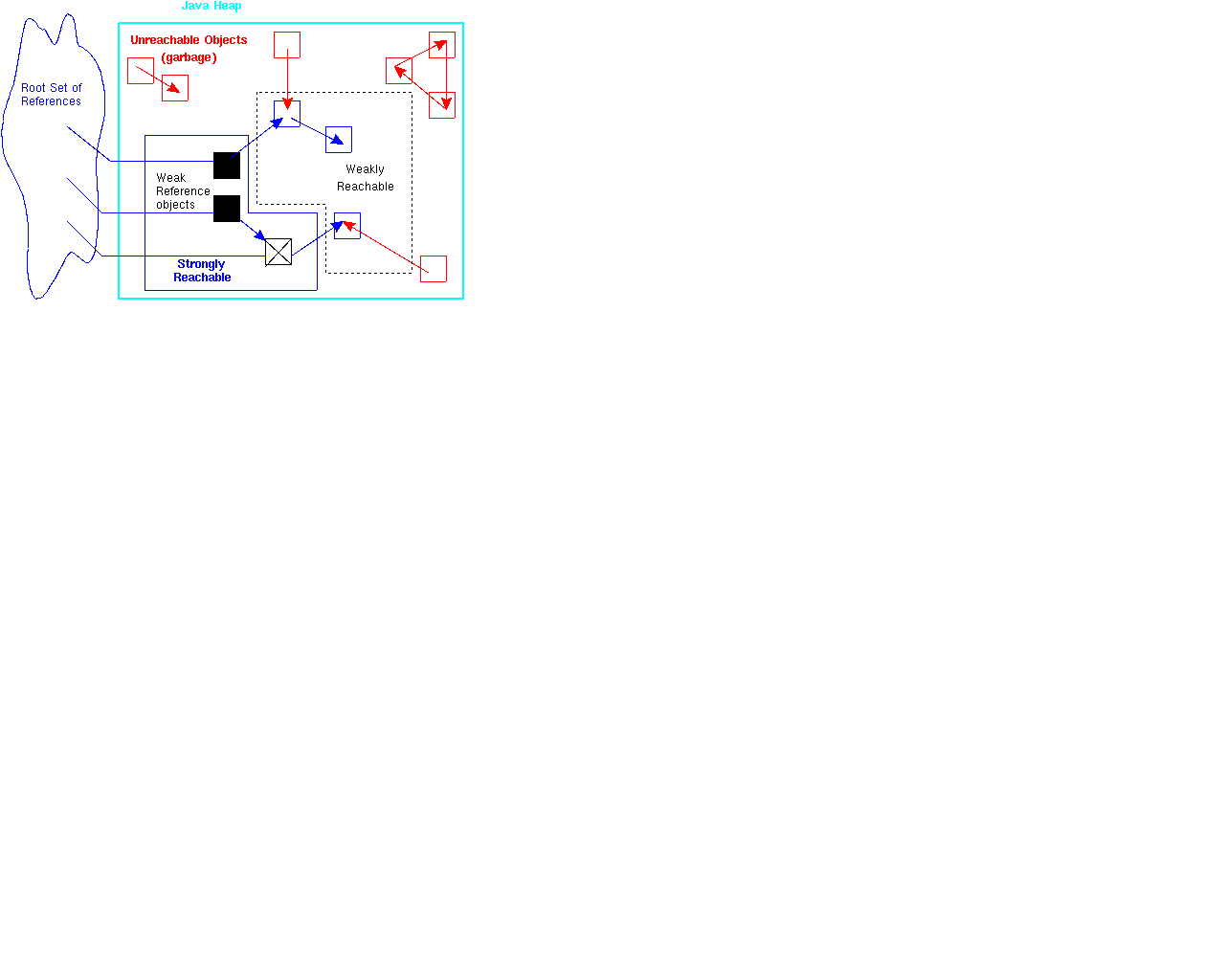
Fig.2: Adding reference objects to the heap.
- Unreachable objects (outside the strongly and
weakly reachable areas) are not reachable from the root set.
- Strongly reachable objects (inside the strongly
reachable area to the lower left) are reachable through at least one path that does not go
through a reference object.
- Weakly reachable objects (inside the weakly
reachable area shown enclosed with a dashed line to the upper-right) are not strongly
reachable through any path, but reachable through at least one path that goes through a
weak reference.
The diagram above shows two paths to the object
on the heap with the X. It can be reached through the weak reference, and directly
from the stack without going through a weak reference object. The object with the X
is strongly reachable and not weakly reachable because one path leads to it from the root
set without going through a reference object. The garbage collection behavior for this
object is the same as other strongly reachable objects until it is no longer reachable
from the root set, at which time it becomes weakly reachable.
Here is another way to look at the same
idea:
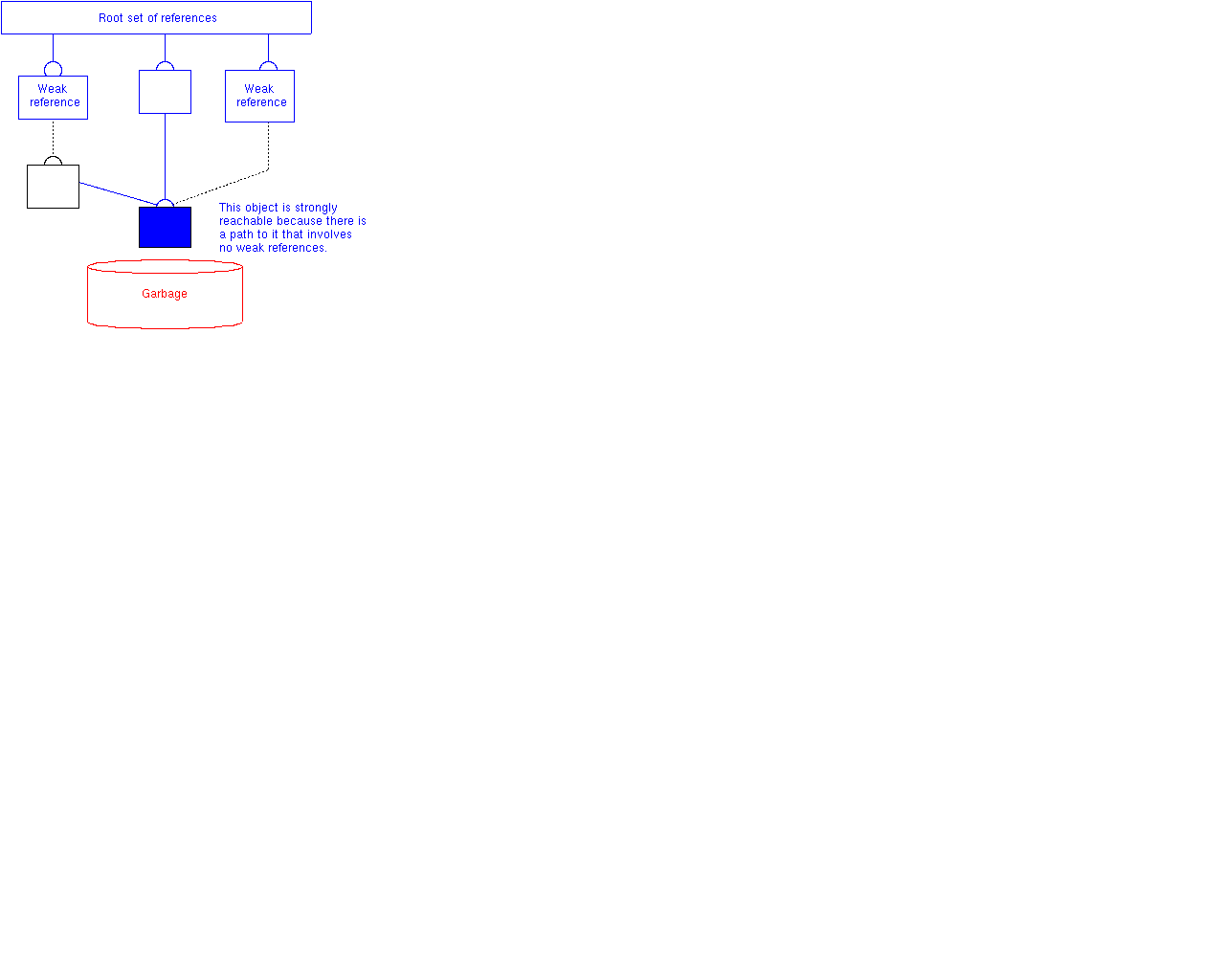
Fig.3: References suspended from a beam.Imagine
the root set of references as a solid beam from which objects are suspended by cables
(strong references). An object might contain references to other objects. Weak reference
objects connect to their referent not by a cable, but by a flexible rubber band, no number
of which could support an object. Objects not held by cables fall into the garbage bin
below.
The Reference Objects API provides several types
of reference objects, which gives a program several strengths of object reachability once
the referent is no longer strongly reachable. The next section explains the different
types of reference objects and what is meant by strengths of reachability.
All About Reference Objects
The Reference Objects API consists of the
classes listed below and shown in the figure.
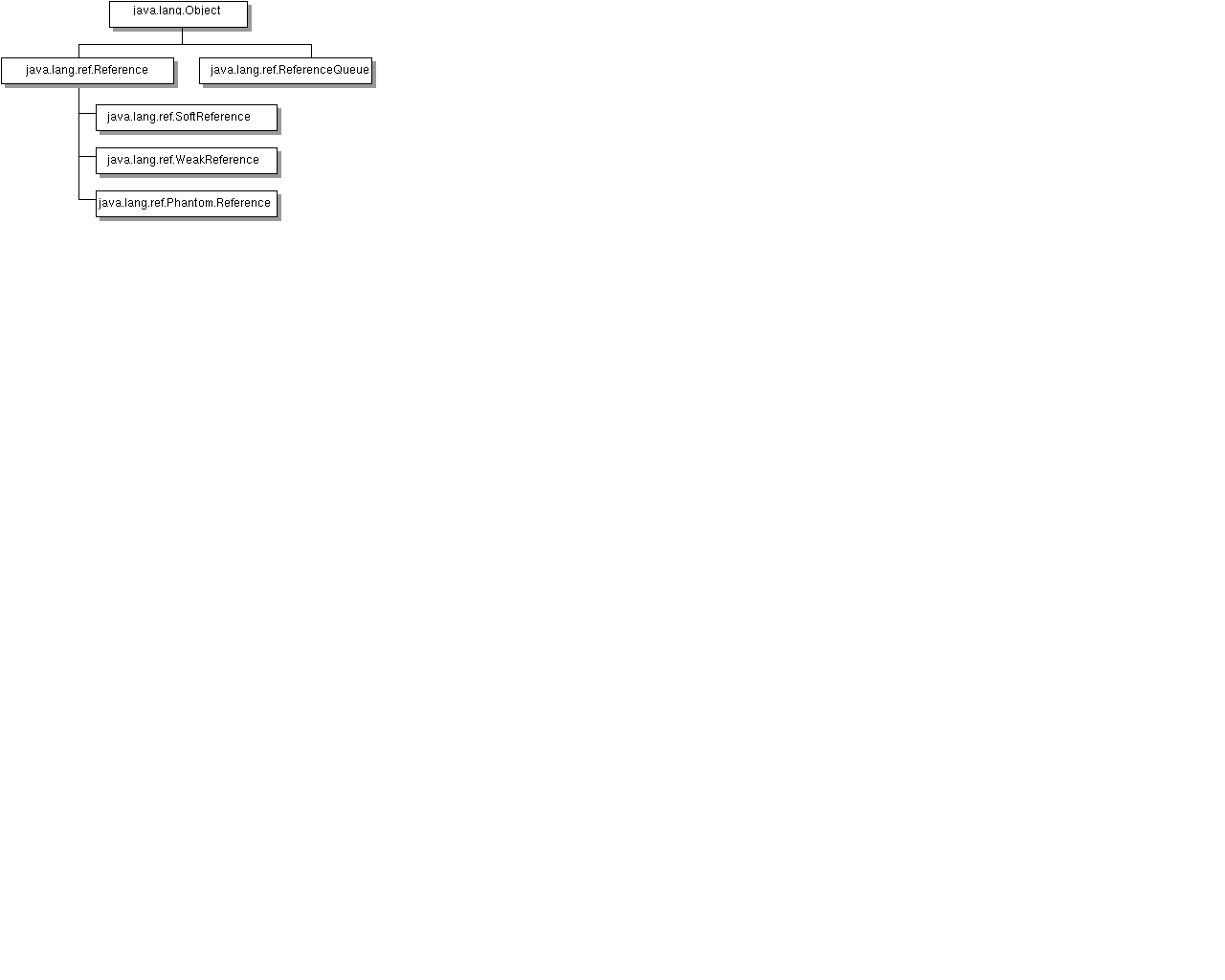
Fig.4: Class hierarchy diagram.The SoftReference,
WeakReference, and PhantomReference classes define three kinds of
reference objects and three strengths of object reachability. From strongest to weakest,
the strengths of reachability are the following:
- Strongly reachable
- Softly rechable
- Weakly reachable
- Phantomly reachable
- Unreachable
See the JDK 1.2 API specification
for the class and method descriptions:
Strengths of Reachability
The Reference Objects API defines strengths of
object reachability. You can have (going from strongest to weakest) softly, weakly and
phantomly reachable objects and gain an amount of interaction with the garbage collector
according to the strength of an object's reachability.
There is no limit to the number or type of
references there can be to an object. One object can be referenced by any mix of strong,
soft, weak, and phantom references depending on your application requirements.
To determine an object's strength of
reachability, the garbage collector starts at the root set and traces all the paths to
objects on the heap. The reference objects that the garbage collector goes through to
reach an object are what determine the reachability of that object. When any path to an
object is free of reference objects, the object is strongly reachable. When all paths have
one or more reference objects, the object is softly, weakly, or phantomly reachable
according to the type of reference object(s) the garbage collector finds. In general, an
object is only as reachable as the weakest link in the strongest path from the root set.
The sections to follow describe how this all works.
Softly Reachable
An object is softly reachable if it is
not strongly reachable and there is a path to it with no weak or phantom references, but
one or more soft references. The garbage collector might or might not reclaim a softly
reachable object depending on how recently the object was created or accessed, but is
required to clear all soft references before throwing an OutOfMemoryError.
If heap memory is running low, the garbage
collector may, at its own discretion, find softly reachable objects that have not been
accessed in the longest time and clear them (set their reference field to null).
SoftReference objects work well in
applications that, for example, put a large number of images into memory and there is no
way to know if the application (driven by end user input) will access a given image again.
If the garbage collector reclaims an image that has not been accessed for a long time, and
the application needs to access it again, the application reloads the image and displays
it.
Using Soft References in Web-Based Programs
Soft references are very useful in web-based
programs where, for example, an applet creates an image to display on a web page. When the
user opens the web page, the applet code gets the image and displays it. If the code also
creates a soft reference to the image, the garbage collector has the option to reclaim or
not reclaim the memory allocated to the image when the user moves to another web page.
Here is how the example application looks in memory:

Fig.5: Using soft references.If the user
returns to the web page where the image is, the applet code uses the SoftReference.get
method to check the soft reference to find out if the image is still in memory. If the
image has not been reclaimed by the garbage collector, it is quickly displayed on the
page; and if the image has been reclaimed, the applet code gets it again.
If your program calls the SoftReference.clear
method, the reference may become eligible for reclamation. However, if there is a strong
reference to the object, calling the clear method does not cause the garbage collector to
reclaim the object. In this case, the soft reference is null, but garbage collection does
not happen until the object is no longer strongly reachable.
Here is the complete DisplayImage.java
source code.
NOTE: The im object is set to null
because there is no gurantee the stack slot occupied by it will be cleared when it goes
out of scope. A later method invocation whose stack frame contains the slot previously
occupied by im might not put a new value there, in which case, the garbage
collector still considers the slot to contain a root.
This is a problem even with non-conservative
exact collectors. As a precaution, you can increase the probability that an object will
become softly, weakly, finalizable, or phantomly reachable by clearing variables that
refer to it.
import java.awt.Graphics;
import java.awt.Image;
import java.applet.Applet;
import java.lang.ref.SoftReference;
public class DisplayImage extends Applet {
SoftReference sr = null;
public void init() {
System.out.println("Initializing");
}
public void paint(Graphics g) {
Image im = (sr == null) ? null : (Image)(sr.get());
if (im == null) {
System.out.println("Fetching image");
im = getImage(getCodeBase(), "truck1.gif");
sr = new SoftReference(im);
}
System.out.println("Painting");
g.drawImage(im, 25, 25, this);
im = null; /* Clear the strong reference to the image */
}
public void start() {
System.out.println("Starting");
}
public void stop() {
System.out.println("Stopping");
}
}
Reference Queues
A java.lang.ref.ReferenceQueue
is a simple data structure onto which the garbage collector places reference objects when
the reference field is cleared (set to null). You would use a reference queue to
find out when an object becomes softly, weakly, or phantomly reachable so your program can
take some action based on that knowledge. For example, a program might perform some
post-finalization cleanup processing that requires an object to be unreachable (such as
the deallocation of resources outside the Java heap) upon learning that an object has
become phantomly reachable.
To be placed on a reference queue, a reference
object must be created with a reference queue. Soft and weak reference objects can be
created with a reference queue or not, but phantom reference objects must be created with
a reference queue:
ReferenceQueue queue = new ReferenceQueue();
PhantomReference pr = new PhantomReference(object, queue);
Another approach to the soft reference example
from the diagram on the previous page could be to create the SoftReference objects with a
reference queue, and poll the queue to find out when an image has been reclaimed (its
reference field cleared). At that point, the program can remove the corresponding entry
from the hash map, and thereby, allow the associated string to be garbage collected.
Note: A program can also wait
indefinitely on a reference queue with the remove() method, or for a bounded
amount of time with the remove(long timeout) method.
Soft and weak reference objects are placed in
their reference queue some time after they are cleared (their reference field is set to null).
Phantom reference objects are placed in their reference queue after they become phantomly
reachable, but before their reference field is cleared. This is so a program can perform
post-finalization cleanup and clear the phantom reference upon completion of the
cleanup.
Weakly Reachable
An object is weakly reachable when the garbage
collector finds no strong or soft references, but at least one path to the object with a
weak reference. Weakly reachable objects are finalized some time after their weak
references have been cleared. The only real difference between a soft reference and a weak
reference is that the garbage collector uses algorithms to decide whether or not to
reclaim a softly reachable object, but always reclaims a weakly reachable object.
Weak references work well in applications that
need to, for example, associate extra data with an unchangeable object, such as a thread
the application did not create. If you make a weak reference to the thread with a
reference queue, your program can be notified when the thread is no longer strongly
reachable. Upon receiving this notification, the program can perform any required cleanup
of the associated data object.
To make the Thread object weakly reachable, its
strong reference must be set to null. After the garbage collector clears the weak
reference to the thread, it places the weak reference on the queue. When the program
removes the reference from the queue, it can then remove the corresponding hash map entry,
and thereby, allow the data object to be reclaimed.
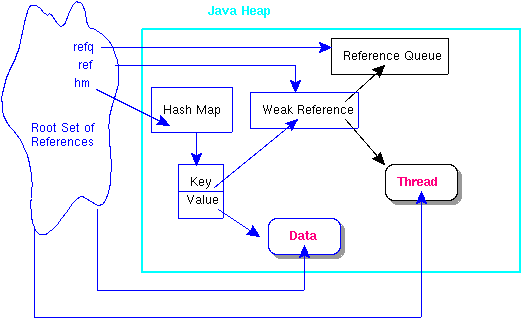
Fig.6: Using weak references.The
following code examples stores an object and some extra data in a hash map. The object is
referenced by a weak reference object that was created with a reference queue. This is a
very simple code example to illustrate the points discussed in this article. In a real
application, the data would be associated with the object well after the object is
created; otherwise, you could keep the data in a subclass of the object instead of using a
weak reference.
After the object becomes weakly reachable, the
garbage collector clears the weak reference and places it in the reference queue. The code
queries the reference queue for the weak reference, and upon finding the weak reference
there, sets the reference to the extra data to null so the extra data is
garbage-collected after the object is.
An important point in this example is that the
object can be reached from the stack through two paths: one path goes through the weak
reference and the other goes through the hash map. The object does not become weakly
reachable until the reference to it in the hash map is null. It is not enough to just set
the object to null.
Here is the complete WeakObj.java
source code.
import java.lang.ref.*;
import java.util.*;
public class WeakObj {
public static void main(String[] args) {
try {
ReferenceQueue aReferenceQueue = new ReferenceQueue();
Object anObject = new Object();
WeakReference ref = new WeakReference(anObject,
aReferenceQueue);
String extraData = new String("Extra Data");
HashMap aHashMap = new HashMap();;
//Associate extraData (value) with weak reference (key) in aHashMap
aHashMap.put(ref, extraData);
//Check that a reference to an object was created
System.out.println("*** created ref to some object");
System.out.println();
System.out.println("contents of ref: " + ref.get());
System.out.println();
//Check whether the Reference Object is enqueued
System.out.println("ref.isEnqueued(): " + ref.isEnqueued());
System.out.println();
//Clear the strong reference to anObject
anObject = null;
//Clear the strong reference to extraData
if(anObject == null){
extraData = null;
}
//Run the garbage collector, and
//Check the reference object's referent
System.out.println("*** running gc...");
System.gc();
System.out.println();
System.out.println("contents of ref: " + ref.get());
System.out.println();
//Check whether the reference object is enqueued
System.out.println("ref.isEnqueued(): " + ref.isEnqueued());
System.out.println();
//Enqueue the reference object. This method returns false
//if the reference object is already enqueued.
System.out.println("enqueued="+ref.enqueue());
} catch (Exception e) {
System.err.println("An exception occurred:");
e.printStackTrace();
}
}
}
Phantomly Reachable
An object is phantomly reachable when the
garbage collector finds no strong, soft, or weak references, but at least one path to the
object with a phantom reference. Phantomly reachable objects are objects that have been
finalized, but not reclaimed.
When the garbage collector finds only phantom
references to an object, it enqueues the phantom reference. The program polls the
reference queue and upon notification that the phantom reference is enqueued, performs
post-finalization cleanup processing that requires the object to be unreachable (such as
the deallocation of resources outside the Java heap). At the end of the post-finalization
cleanup code, the program should call the clear() method on the phantom reference
object to set the reference field to null to make the referent eligible for
garbage collection.
Chains of reference objects
A given path to an object can contain more than
one kind of reference object, which creates a chain of reference objects. The garbage
collector processes reference objects in order from strongest to weakest. The processing
always happens in the following order, but there is no guarantee when the processing will
occur:
- Soft references
- Weak references
- Finalization
- Phantom references
- Reclamation
In the diagram below, there is a chain of
reference objects to Some Object. When the garbage collector processes the reference
objects, will it find Some Object to be phantomly, weakly, or softly reachable?

Fig.7: How reachable is some object?.The
answer is Some object is phantomly reachable. In general an object is only as reachable as
the weakest link in the strongest path from a root set. In the diagram, the phantom
reference is strongly reachable, but all other objects are phantomly reachable.
However, if the weak reference is strongly
reachable as shown in the next diagram, both Phantom and Weak reference are strongly
reachable, and Soft reference and Some object are weakly reachable.
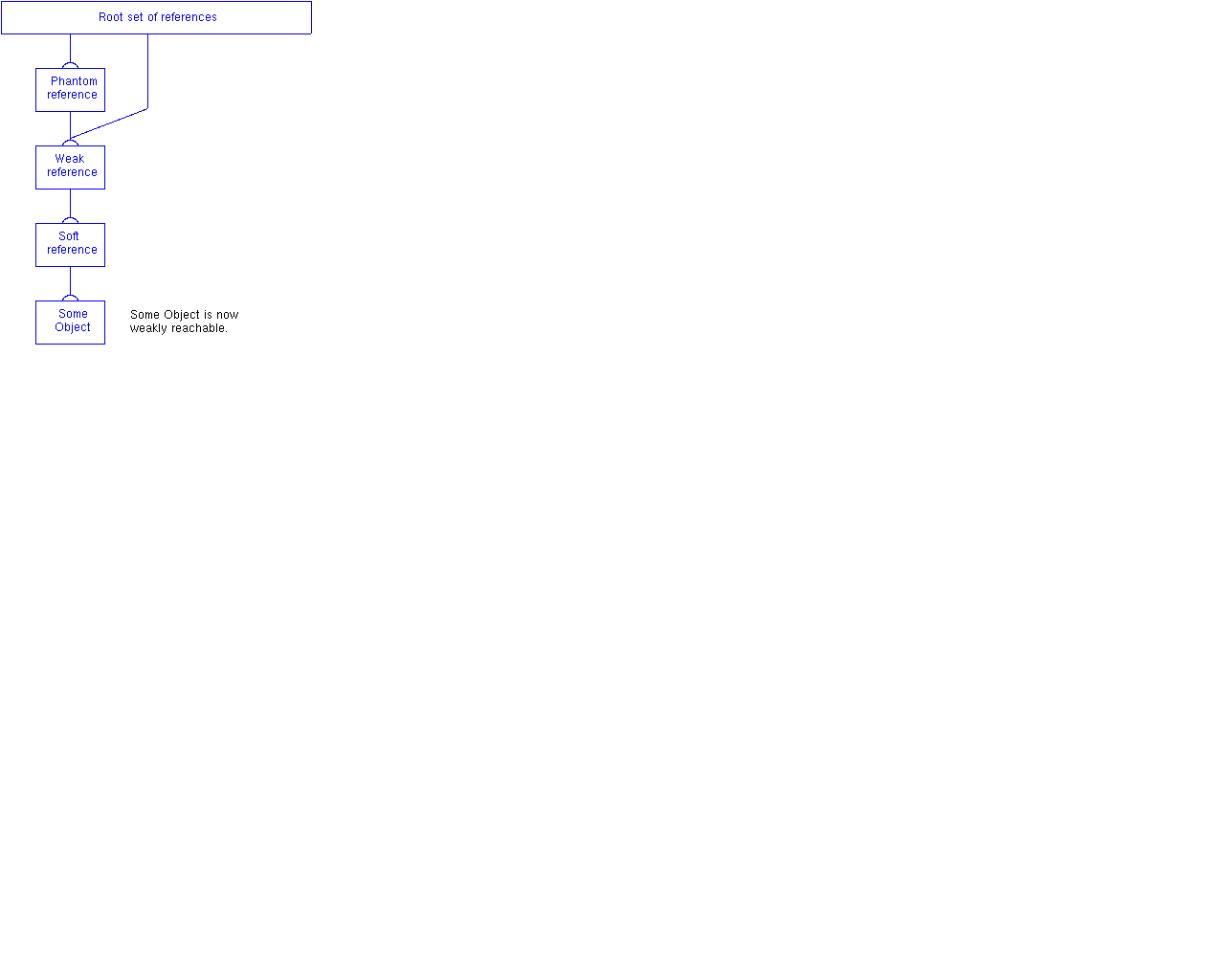
Fig.8: Phantomly or weakly reachable?.Can
you guess what happens if Soft reference is strongly reachable?
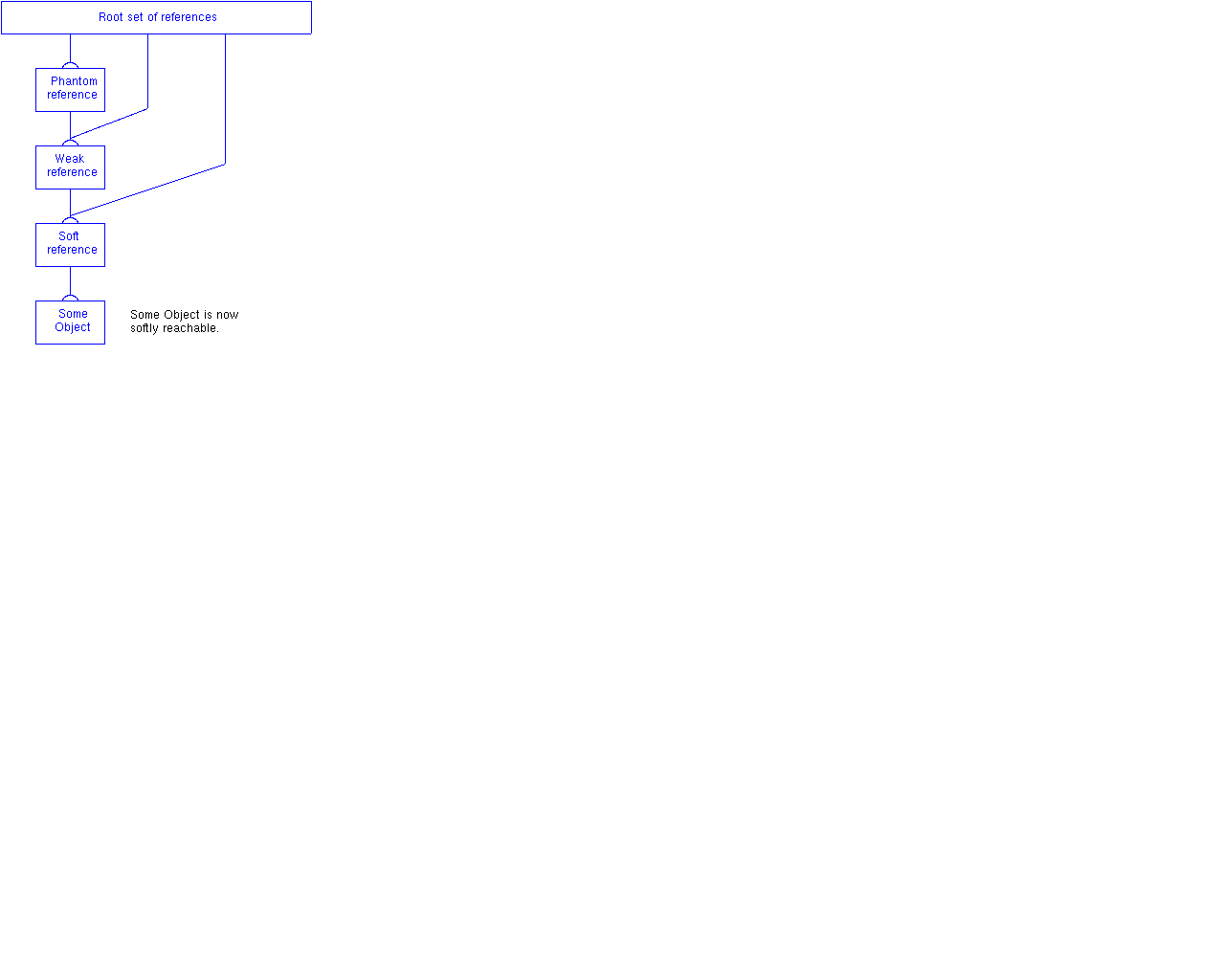
Fig. 9: Phantomly, weakly, or softly
reachable?.The answer is Phantom, Weak, and Soft reference are strongly reachable, and
Some Object is softly reachable.
WeakHashMap Class
A WeakHashMap object is like a HashMap
object in that it stores key-value pairs where the key is an arbitrary object. But, in a WeakHashMap
object, the key is referenced by a weak reference object internal to the WeakHashMap
object.
After the object referenced by the weak key
becomes weakly reachable, the garbage collector clears the internal weak reference. At
this point, the key and its associated value become eligible for finalization, and if
there are no phantom references to the key, the key and value then become eligible for
reclamation. The WeakHashMap class provides a weak hash table facility, but in a class
that fits into the new Collections
framework.
If you use a WeakHashMap object instead
of the HashMap and WeakReference objects, you can associate pairs of
objects as keys and values. The value is made eligible for garbage collection when the key
becomes weakly reachable. This uses fewer lines of code because you do not need a WeakReference
object, and you do not have to explicitly set the associated object to null.
Conclusion
If you have ever wanted the garbage collector to
reclaim unused objects when heap memory is running low, or a convenient way to be sure an
object is collected when an object it is related to is no longer in use, the JDK 1.2
Reference Objects API is for you. Not only do you get some control over garbage
collection, but your programs will run better too.

Monica Pawlan is a staff writer on the JDC team.
She has a background in 2D and 3D graphics, security, database products, and loves to
explore emerging technologies.
monica.pawlan@eng.sun.com
 The Reference Object
application programming interface (API) is new in the Java™ Development Kit
(JDK™) 1.2. This API allows a program to maintain special references to objects that
allow the program to interact with the garbage collector in limited ways. Not all programs
require this level of interaction with the garbage collector. For example, a program that
keeps a lot of objects in memory or a program that needs to perform cleanup operations on
related objects before an object is reclaimed might be good candidates for using the
Reference Objects API.
The Reference Object
application programming interface (API) is new in the Java™ Development Kit
(JDK™) 1.2. This API allows a program to maintain special references to objects that
allow the program to interact with the garbage collector in limited ways. Not all programs
require this level of interaction with the garbage collector. For example, a program that
keeps a lot of objects in memory or a program that needs to perform cleanup operations on
related objects before an object is reclaimed might be good candidates for using the
Reference Objects API. 







